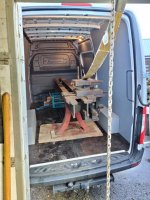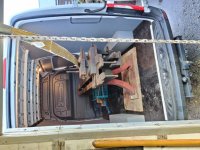I picked up this bed as the base for a significant wood lathe (center height 16"-20").
The bed has no markings in the cast. There were no headstock nor tailstock with it, it had cracks on both sides inside the carriage way (repaired with a strip and some bolts) and the connection between carriage way and leadscrew was broken and missing. In short, it had a hard life and it was used as a base for some drilling gizmo's which probably saved it from being scrapped.
The bed measures 112" long and 12" wide. I picked it up in southern Germany, quite close to Maxhütte, which was a significant steel mill in Germany until about 25 years ago.

Anyway, I´d be interested to learn how old this lathe is - I know metal lathes got prism beds pretty early, but people on owwm.org mentioned (wenn did metal lathes transition from flat to prism beds? - Old Woodworking Machines) that dovetail beds like this one were never really common and typically European. Also, "Flat ways were used on lower quality lathes well into the twentieth century". In this case, lower quality must be about the accuracy as a metal lathe, since the bed is in pretty good condition for my purposes.


The dovetail form is recognizable here.
Can anybody tell me anything about the probable age of this bed?
The bed has no markings in the cast. There were no headstock nor tailstock with it, it had cracks on both sides inside the carriage way (repaired with a strip and some bolts) and the connection between carriage way and leadscrew was broken and missing. In short, it had a hard life and it was used as a base for some drilling gizmo's which probably saved it from being scrapped.
The bed measures 112" long and 12" wide. I picked it up in southern Germany, quite close to Maxhütte, which was a significant steel mill in Germany until about 25 years ago.

Anyway, I´d be interested to learn how old this lathe is - I know metal lathes got prism beds pretty early, but people on owwm.org mentioned (wenn did metal lathes transition from flat to prism beds? - Old Woodworking Machines) that dovetail beds like this one were never really common and typically European. Also, "Flat ways were used on lower quality lathes well into the twentieth century". In this case, lower quality must be about the accuracy as a metal lathe, since the bed is in pretty good condition for my purposes.


The dovetail form is recognizable here.
Can anybody tell me anything about the probable age of this bed?




 some wear was present allright - the connection between saddle and leadscrew was broken off. That may be the main reason this bed was just used as a base/stand for some drilling gizmos, as I wrote at the start. It wasn't usable as a lathe anymore.
some wear was present allright - the connection between saddle and leadscrew was broken off. That may be the main reason this bed was just used as a base/stand for some drilling gizmos, as I wrote at the start. It wasn't usable as a lathe anymore.